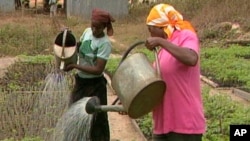The Horn of Africa is facing its worst drought in decades and aid agencies are appealing to the international community for immediate help to save hundreds of thousands of people at risk of starvation. Relief experts also say long-term solutions are needed to address underlying problems with African agriculture.
Kaltun Nur fled her home in western Somalia to seek help in Mogadishu. “We endured hunger and we waited for the rains. Our livestock died and we had a farm we were forced to sell so we can travel to Mogadishu. By that time we were eating grass,” Kaltun Nur said.
Fardosa Farah walked for 25 days to get to the Dadaab camp in neighboring Kenya. “This drought wiped out everything we had. If there’s anybody willing to remain there, then I think it is just attempted suicide,” Farah said.
Farah and Nur are among many Africans who've sought shelter and food at refugee camps in recent weeks. And as thousands more cross the border into Kenya, aid agencies are sounding the alarm. United Nations High Commissioner for Refugees Antonio Guterres.
“I have no doubt that Somalia is today the worst humanitarian disaster we face in the world. Here in the outskirts of the Somali refugee camp of Dadaab, we have the most vulnerable of the vulnerable in the world,” Guterres said.
Mofatt Ngugi is a climate change adviser with the Bureau for Food Security at the U.S. Agency for International Development. He says one of the problems in East Africa is that people rely mostly on pastoralism.
“In the Western African region, a lot of the production systems there are much more integrated in terms of agro-pastoralism. That is not the case in regions of the Horn of Africa where people are purely pastoralists. So they are dependent entirely on livestock system,” Ngugi said.
Melinda Kimble, vice-president at the U.N. Foundation, says there is an even deeper issue. “I think the underlying problem gets to governance and probably to a large extent the inability of the public sector to invest in both the infrastructure, research and science innovation that’s needed to change the approach," Kimble said.
Kimble says African farmers have been going through a rough time for years.
“In the mid-70s, we saw a lot of cycles that caused a lot of hardship. In the mid-80s, we had the Ethiopian crisis, and we had recurring crisis from 1980s to 1998 in Somalia, Eritrea and the Horn of Africa. All these areas are fragile lands,” Kimble said.
But Mofatt Ngugi says there are no quick fixes. So, in June, the U.S. launched a new program - Feed the Future - aimed at fighting food insecurities.
“Within Feed the Future, there is explicit geographic focus on what is appropriate for particular regions. The other approach that is being pursued is one that develops markets, a value-chain approach that facilitates not only increased sustainable production but also availing markets to these communities. So they can not only produce for their own use but also engage in the larger economy,” Mofatt said.
Melinda Kimble says the general lack of rain, and frequent droughts, will continue to plague East African agriculture, but there are still ways to improve production.
"You can do more water harvesting and more water conservation or identify better crops. // You need to invest more in the lost crops of Africa like cow peas and yams which are highly nutritive but not produced in big volume,” Kimble said.
The United Nations says more than two million children in East Africa are malnourished, and a half million are in need of urgent life-saving actions. Also needed: more effective early warning systems, FEWSNET for example, to forecast droughts.
Agencies Seek Immediate, Long-Term Solutions for Horn of Africa











